stop start YAMAHA VX LIMITED HO 2022 Owners Manual
[x] Cancel search | Manufacturer: YAMAHA, Model Year: 2022, Model line: VX LIMITED HO, Model: YAMAHA VX LIMITED HO 2022Pages: 112, PDF Size: 4.8 MB
Page 7 of 112

Table of contents
General and important labels ........... 1Identification numbers .................... 1
Primary Identification (PRI-ID)
number............................................ 1
Craft Identification Number (CIN) ....... 1
Engine serial number.......................... 1
Manufactured date label .................... 2
Model information ........................... 3
Builder’s plate .................................... 3
Important labels .............................. 4
Warning labels.................................... 5
Other labels ........................................ 8
Safety information ............................. 9 Limitations on who may operate the watercraft ............................... 9
Cruising limitations ........................ 10
Operation requirements ................ 11
Recommended equipment ........... 13
Hazard information........................ 14
Watercraft characteristics ............. 14
Wakeboarding and water-skiing ... 16
Safe boating rules ......................... 17
Enjoy your watercraft responsibly ................................. 18
Description....................................... 19 Watercraft glossary ....................... 19
Location of main components ...... 20
Control function operation ............. 24 Watercraft control functions ......... 24
Yamaha Security System ................. 24
Engine start/stop switch ................. 25
Engine shut-off switch .................... 25
Throttle lever .................................... 25
RiDE lever ........................................ 26
Steering system ............................... 26
Cooling water pilot outlet ................. 26
Water separator................................ 27
Watercraft operation ...................... 28Watercraft operation functions ..... 28
Shift system ..................................... 28
Watercraft operation modes ......... 31
Reverse assist .................................. 31
T.D.E.
(thrust directional enhancer) ......... 31
No-wake mode ................................. 32
Drive control mode ........................... 33
Cruise assist ..................................... 35
Instrument operation ...................... 37 Multifunction information center ... 37
Operation buttons ............................ 37
Display.............................................. 37
Home screen ................................... 39
Information screen .......................... 39
Drive control mode screen .............. 40
Setting menu screen ....................... 40
Engine lock screen .......................... 41
Warning function .............................. 42
Audio system (equipped models) ..................... 44
Audio control .................................... 44
Accessory outlet ........................... 45
USB charger ................................. 46
Equipment operation ...................... 47 Equipment..................................... 47
Seats ................................................ 47
Handgrip........................................... 48
Reboarding grip................................ 48
Reboarding step ............................... 48
Bow eye............................................ 49
Stern eyes ........................................ 49
Cleat ................................................. 49
Pull-up cleats ................................... 50
Storage compartments .................... 50
Fire extinguisher holder and cover ... 53
UF4S71E0.book Page 1 Wednesday, August 4, 2021 5:18 PM
Page 8 of 112

Table of contents
Operation and handling
requirements ................................... 54Fuel requirements ......................... 54
Fuel................................................... 54
Engine oil requirements ................ 56
Engine oil .......................................... 56
Draining the bilge water ................ 58
Draining the bilge water on land ...... 58
Draining the bilge water on water .... 58
Transporting on a trailer ................ 59
First-time operation ........................ 60 Engine break-in ............................. 60
Pre-operation checks ..................... 61
Pre-operation checklist .................... 61
Pre-operation check points........... 63
Pre-launch checks ........................... 63
Post-launch checks ......................... 68
Operation ......................................... 70 Operating your watercraft ............. 70
Getting to know your watercraft ...... 70
Learning to operate your
watercraft ...................................... 70
Riding position ................................. 71
Launching the watercraft ................. 71
Starting the engine on water ............ 71
Stopping the engine ......................... 72
Leaving the watercraft...................... 72
Operating the watercraft .................. 72
Turning the watercraft ...................... 73
Stopping the watercraft ................... 74
Operating the watercraft in reverse or neutral ...................................... 75
Boarding the watercraft ................... 76
Starting off........................................ 78
Capsized watercraft ......................... 79
Beaching and docking the watercraft ...................................... 80
Operating in weeded areas .............. 80
After removing the watercraft from
the water ....................................... 81
Care and storage ............................ 82Post-operation care ...................... 82
Flushing the cooling water
passages....................................... 82
Cleaning the watercraft .................... 83
Battery care ...................................... 83
Long-term storage ........................ 85
Cleaning ........................................... 85
Lubrication ....................................... 85
Rustproofing ..................................... 86
Maintenance .................................... 87 Maintenance ................................. 87
Removing and installing the engine
cover ............................................. 87
Periodic maintenance chart ............. 89
Engine oil and oil filter ...................... 91
Specifications .................................. 92 Specifications ............................... 92
Trouble recovery ............................. 94 Troubleshooting ............................ 94
Troubleshooting chart ...................... 94
Emergency procedures ................ 97
Cleaning the jet intake and
impeller ......................................... 97
Raising the reverse gate .................. 98
Jumping the battery ......................... 98
Towing the watercraft....................... 99
Submerged watercraft ..................... 99
Index............................................... 101
UF4S71E0.book Page 2 Wednesday, August 4, 2021 5:18 PM
Page 20 of 112
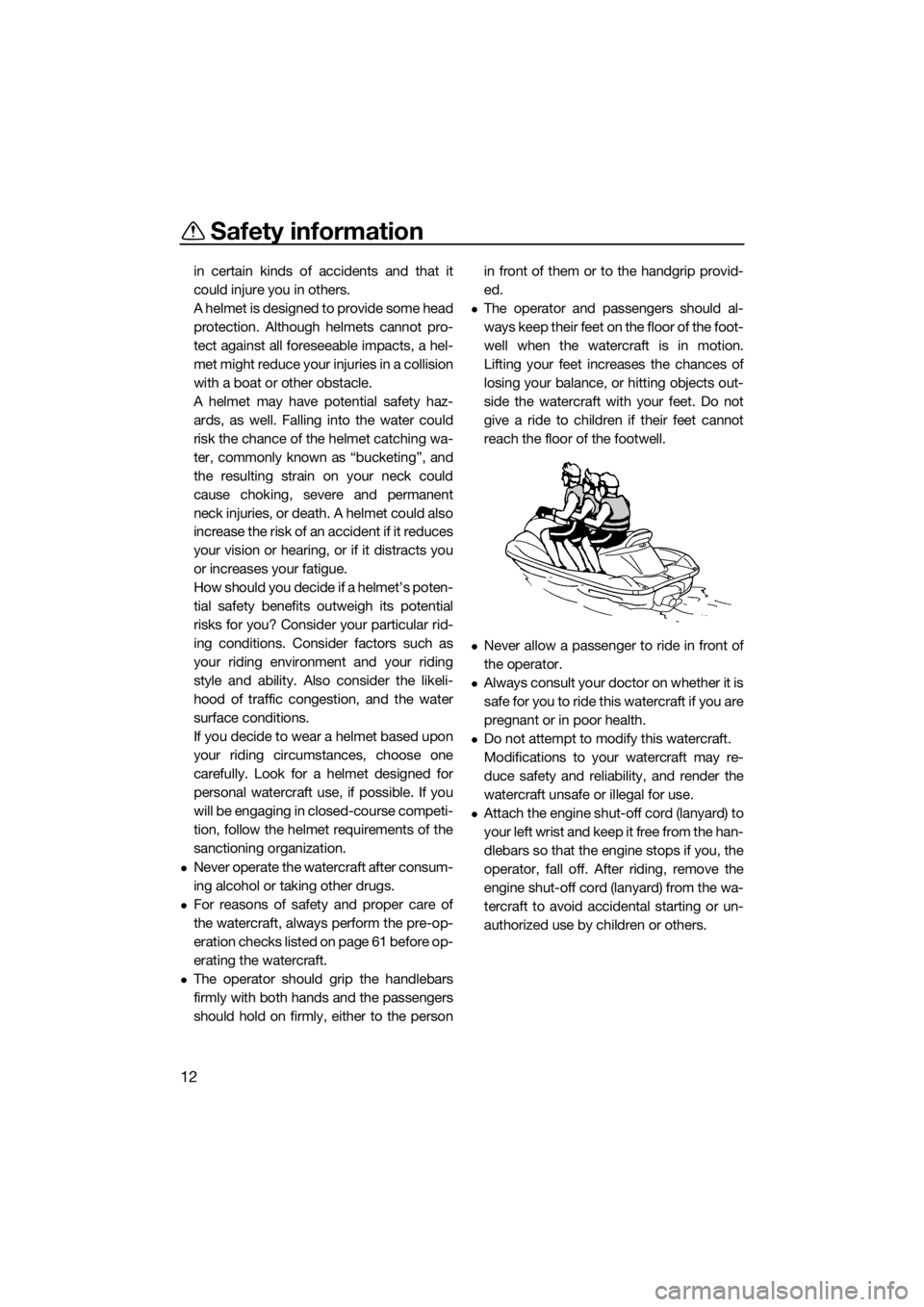
Safety information
12
in certain kinds of accidents and that it
could injure you in others.
A helmet is designed to provide some head
protection. Although helmets cannot pro-
tect against all foreseeable impacts, a hel-
met might reduce your injuries in a collision
with a boat or other obstacle.
A helmet may have potential safety haz-
ards, as well. Falling into the water could
risk the chance of the helmet catching wa-
ter, commonly known as “bucketing”, and
the resulting strain on your neck could
cause choking, severe and permanent
neck injuries, or death. A helmet could also
increase the risk of an accident if it reduces
your vision or hearing, or if it distracts you
or increases your fatigue.
How should you decide if a helmet’s poten-
tial safety benefits outweigh its potential
risks for you? Consider your particular rid-
ing conditions. Consider factors such as
your riding environment and your riding
style and ability. Also consider the likeli-
hood of traffic congestion, and the water
surface conditions.
If you decide to wear a helmet based upon
your riding circumstances, choose one
carefully. Look for a helmet designed for
personal watercraft use, if possible. If you
will be engaging in closed-course competi-
tion, follow the helmet requirements of the
sanctioning organization.
Never operate the watercraft after consum-
ing alcohol or taking other drugs.
For reasons of safety and proper care of
the watercraft, always perform the pre-op-
eration checks listed on page 61 before op-
erating the watercraft.
The operator should grip the handlebars
firmly with both hands and the passengers
should hold on firmly, either to the person in front of them or to the handgrip provid-
ed.
The operator and passengers should al-
ways keep their feet on the floor of the foot-
well when the watercraft is in motion.
Lifting your feet increases the chances of
losing your balance,
or hitting objects out-
side the watercraft with your feet. Do not
give a ride to children if their feet cannot
reach the floor of the footwell.
Never allow a passenger to ride in front of
the operator.
Always consult your doctor on whether it is
safe for you to ride this watercraft if you are
pregnant or in poor health.
Do not attempt to modify this watercraft.
Modifications to your watercraft may re-
duce safety and reliability, and render the
watercraft unsafe or illegal for use.
Attach the engine shut-off cord (lanyard) to
y o u r l ef t w r is t an d k ee p i t fr e e f r o m t h e h an -
dlebars so that the engine stops if you, the
operator, fall off. After riding, remove the
engine shut-off cord (lanyard) from the wa-
tercraft to avoid accidental starting or un-
authorized use by children or others.
UF4S71E0.book Page 12 Wednesday, August 4, 2021 5:18 PM
Page 30 of 112
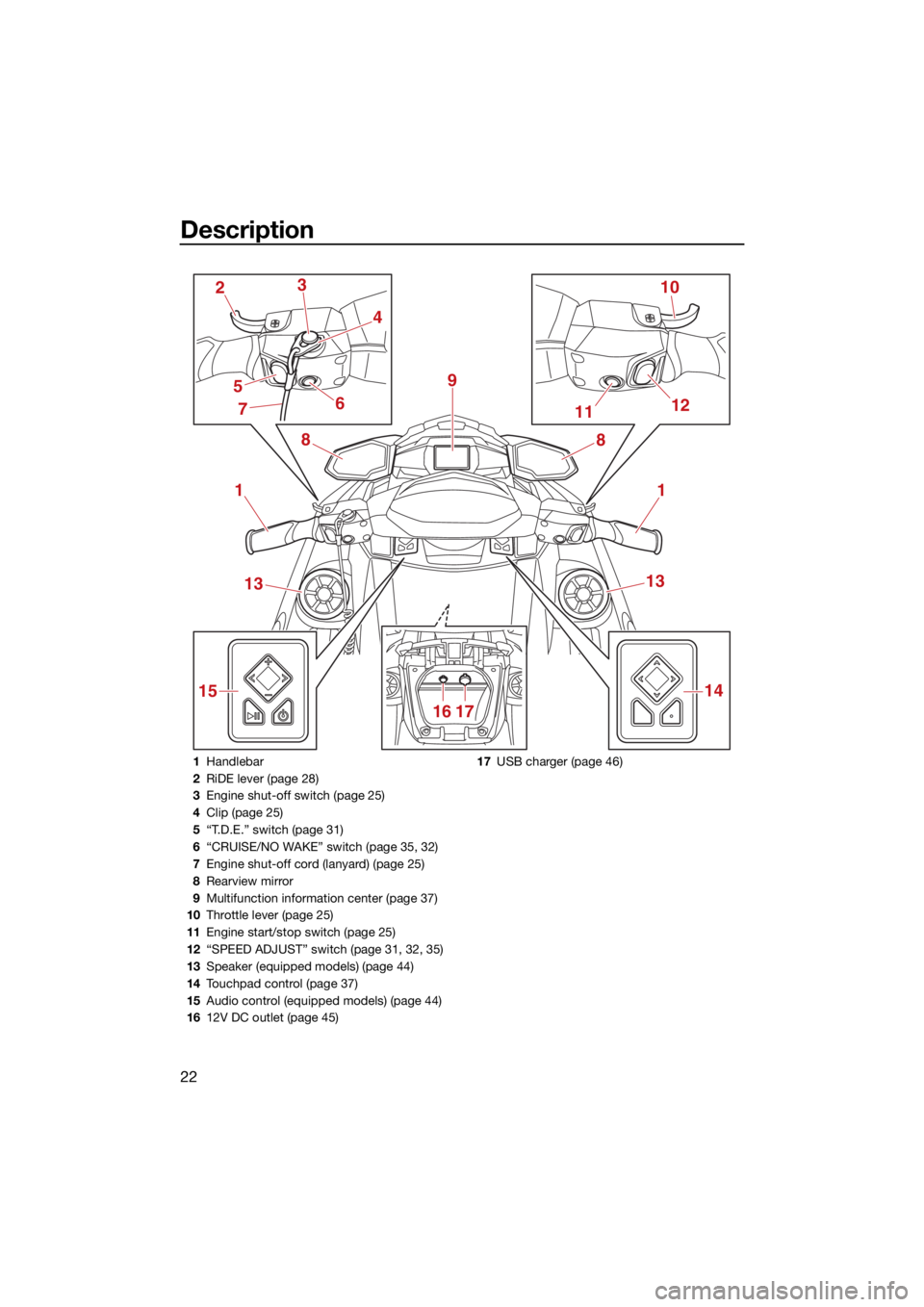
Description
22
1
2
1112
15 10
3
6 8
9
4
51
13
14
16 17 13
8
7
1
Handlebar
2 RiDE lever (page 28)
3 Engine shut-off switch (page 25)
4 Clip (page 25)
5 “T.D.E.” switch (page 31)
6 “CRUISE/NO WAKE” switch (page 35, 32)
7 Engine shut-off cord (lanyard) (page 25)
8 Rearview mirror
9 Multifunction information center (page 37)
10 Throttle lever (page 25)
11 Engine start/stop switch (page 25)
12 “SPEED ADJUST” switch (page 31, 32, 35)
13 Speaker (equipped models) (page 44)
14 Touchpad control (page 37)
15 Audio control (equipped models) (page 44)
16 12V DC outlet (page 45) 17
USB charger (page 46)
UF4S71E0.book Page 22 Wednesday, August 4, 2021 5:18 PM
Page 32 of 112

Control function operation
24
EJU31027
Watercraft control functionsEJU45091Yamaha Security System
The Yamaha Security System functions to
help prevent unauthorized use or theft of the
watercraft. The lock and unlock modes of the
security system can be selected using the
engine lock screen of the multifunction infor-
mation center. The engine cannot be started
if the lock mode of the security system is se-
lected. The engine can only be started if the
unlock mode is selected.
TIP
The Yamaha Security System setting can
only be selected while the engine is stopped.
EJU45870Yamaha Security System settingThe Yamaha Security System setting can be
confirmed by the lock or unlock mode indica-
tor on the multifunction information center.
To select the lock or unlock mode of the
Yamaha Security System:
(1) Stop the engine.
TIP
The multifunction information center is turned
on, even if the engine start/stop switch is also
pushed briefly.
(2) Select the lock or unlock mode indicator
on the multifunction information center.
(3) Input each digit of the 4-digit PIN, and then push the “OK” button of the touch-
pad control.
TIP
The default setting for the PIN is “1234”. The
PIN can also be changed. (See page 40 for in-
formation on changing the PIN.)
(4) To select the lock mode of the YamahaSecurity System, select “ON”. To select
the unlock mode, select “OFF”.
(5) The beeper sounds once when the lock mode of the Yamaha Security System is
selected, and two times when the unlock
mode is selected.
1Lock mode indicator
2 Unlock mode indicator
2
1
Enter PIN
* * * *123
456
789
0
Engine Lock
ON
OFF
UF4S71E0.book Page 24 Wednesday, August 4, 2021 5:18 PM
Page 33 of 112
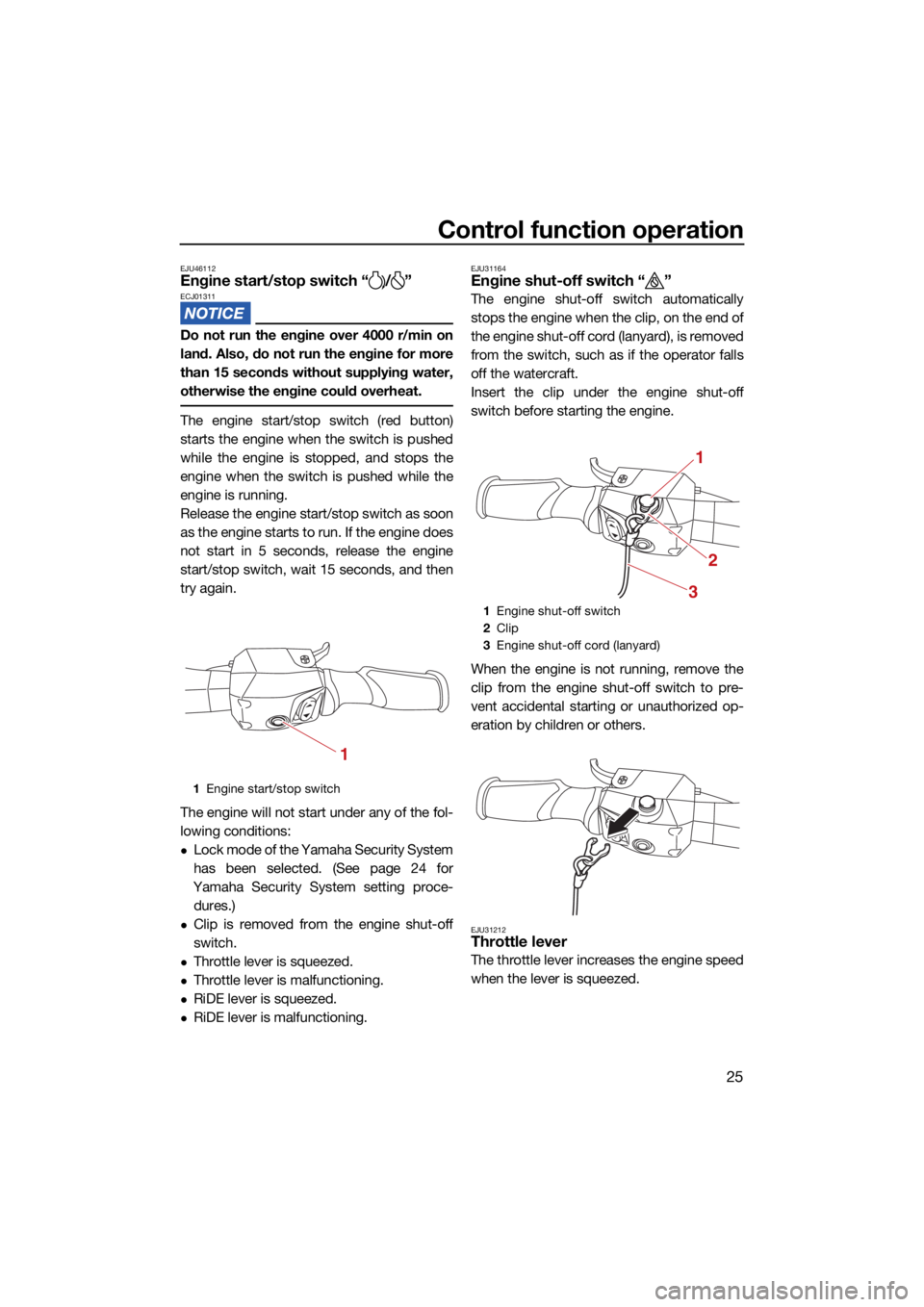
Control function operation
25
EJU46112Engine start/stop switch “ / ”ECJ01311
Do not run the engine over 4000 r/min on
land. Also, do not run the engine for more
than 15 seconds without supplying water,
otherwise the engine could overheat.
The engine start/stop switch (red button)
starts the engine when the switch is pushed
while the engine is stopped, and stops the
engine when the switch is pushed while the
engine is running.
Release the engine start/stop switch as soon
as the engine starts to run. If the engine does
not start in 5 seconds, release the engine
start/stop switch, wait 15 seconds, and then
try again.
The engine will not start under any of the fol-
lowing conditions:
Lock mode of the Yamaha Security System
has been selected. (See page 24 for
Yamaha Security System setting proce- dures.)
Clip is removed from the engine shut-off
switch.
Throttle lever is squeezed.
Throttle lever is malfunctioning.
RiDE lever is squeezed.
RiDE lever is malfunctioning.
EJU31164Engine shut-off switch “ ”
The engine shut-off switch automatically
stops the engine when the clip, on the end of
the engine shut-off cord (lanyard), is removed
from the switch, such as if the operator falls
off the watercraft.
Insert the clip under the engine shut-off
switch before starting the engine.
When the engine is not running, remove the
clip from the engine shut-off switch to pre-
vent accidental starting or unauthorized op-
eration by children or others.
EJU31212Throttle lever
The throttle lever increases the engine speed
when the lever is squeezed.
1 Engine start/stop switch
1
1Engine shut-off switch
2 Clip
3 Engine shut-off cord (lanyard)
1
2
3
UF4S71E0.book Page 25 Wednesday, August 4, 2021 5:18 PM
Page 34 of 112
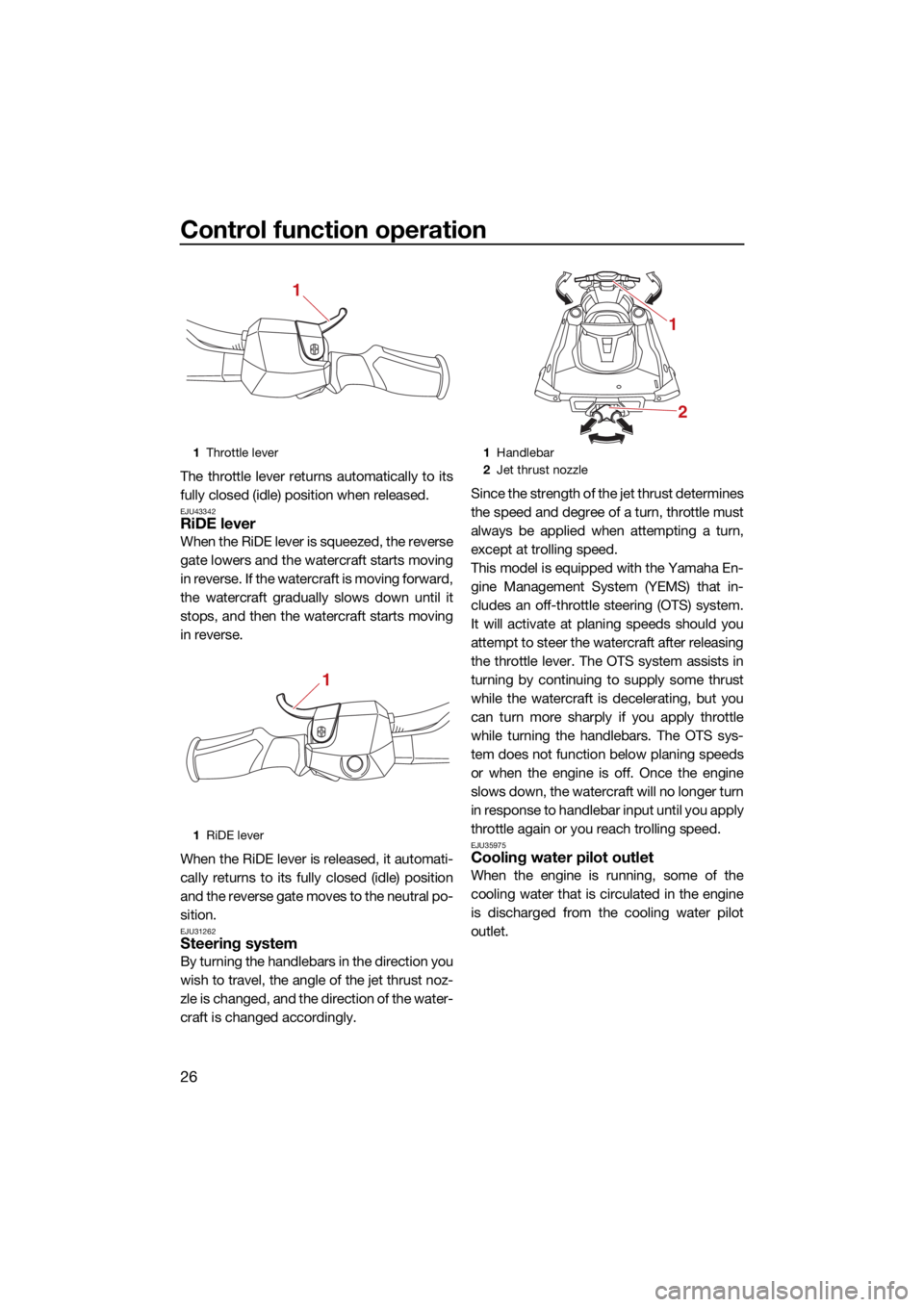
Control function operation
26
The throttle lever returns automatically to its
fully closed (idle) position when released.
EJU43342RiDE lever
When the RiDE lever is squeezed, the reverse
gate lowers and the watercraft starts moving
in reverse. If the watercraft is moving forward,
the watercraft gradually slows down until it
stops, and then the watercraft starts moving
in reverse.
When the RiDE lever is released, it automati-
cally returns to its fully closed (idle) position
and the reverse gate moves to the neutral po-
sition.
EJU31262Steering system
By turning the handlebars in the direction you
wish to travel, the angle of the jet thrust noz-
zle is changed, and the direction of the water-
craft is changed accordingly.Since the strength of the jet thrust determines
the speed and degree of a turn, throttle must
always be applied when attempting a turn,
except at trolling speed.
This model is equipped with the Yamaha En-
gine Management System (YEMS) that in-
cludes an off-throttle steering (OTS) system.
It will activate at planing speeds should you
attempt to steer the watercraft after releasing
the throttle lever. The OTS system assists in
turning by continuing to supply some thrust
while the watercraft is decelerating, but you
can turn more sharply if you apply throttle
while turning the handlebars. The OTS sys-
tem does not function below planing speeds
or when the engine is off. Once the engine
slows down, the watercraft will no longer turn
in response to handlebar input until you apply
throttle again or you reach trolling speed.
EJU35975Cooling water pilot outlet
When the engine is running, some of the
cooling water that is circulated in the engine
is discharged from the cooling water pilot
outlet.
1
Throttle lever
1 RiDE lever
1
1
1Handlebar
2 Jet thrust nozzle
1
2
UF4S71E0.book Page 26 Wednesday, August 4, 2021 5:18 PM
Page 35 of 112
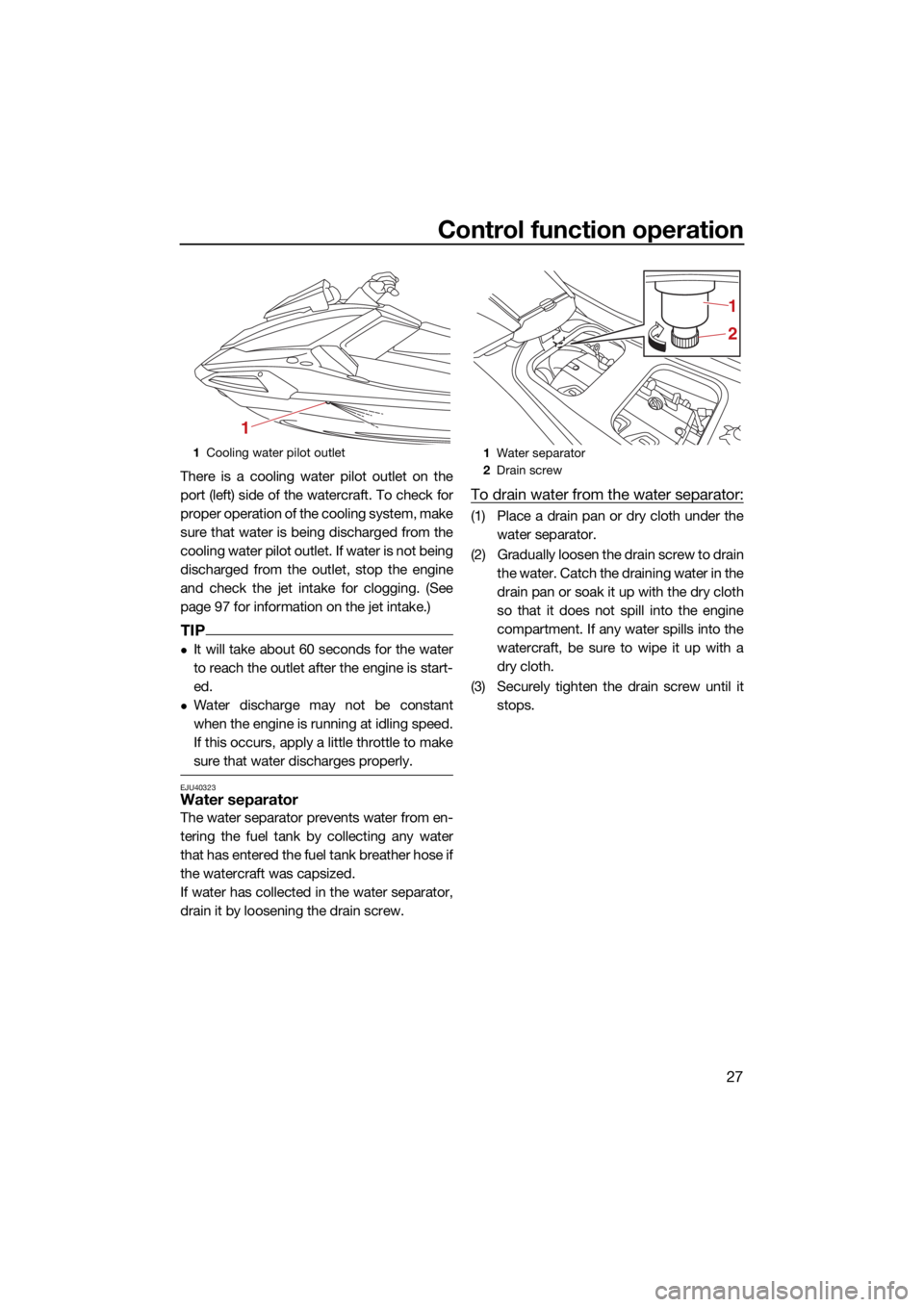
Control function operation
27
There is a cooling water pilot outlet on the
port (left) side of the watercraft. To check for
proper operation of the cooling system, make
sure that water is being discharged from the
cooling water pilot outlet. If water is not being
discharged from the outlet, stop the engine
and check the jet intake for clogging. (See
page 97 for information on the jet intake.)
TIP
It will take about 60 seconds for the water
to reach the outlet after the engine is start-
ed.
Water discharge may not be constant
when the engine is running at idling speed.
If this occurs, apply a little throttle to make
sure that water discharges properly.
EJU40323Water separator
The water separator prevents water from en-
tering the fuel tank by collecting any water
that has entered the fuel tank breather hose if
the watercraft was capsized.
If water has collected in the water separator,
drain it by loosening the drain screw.
To drain water from the water separator:
(1) Place a drain pan or dry cloth under thewater separator.
(2) Gradually loosen the drain screw to drain the water. Catch the draining water in the
drain pan or soak it up with the dry cloth
so that it does not spill into the engine
compartment. If any water spills into the
watercraft, be sure to wipe it up with a
dry cloth.
(3) Securely tighten the drain screw until it stops.
1Cooling water pilot outlet
1
1Water separator
2 Drain screw
2 1
UF4S71E0.book Page 27 Wednesday, August 4, 2021 5:18 PM
Page 40 of 112
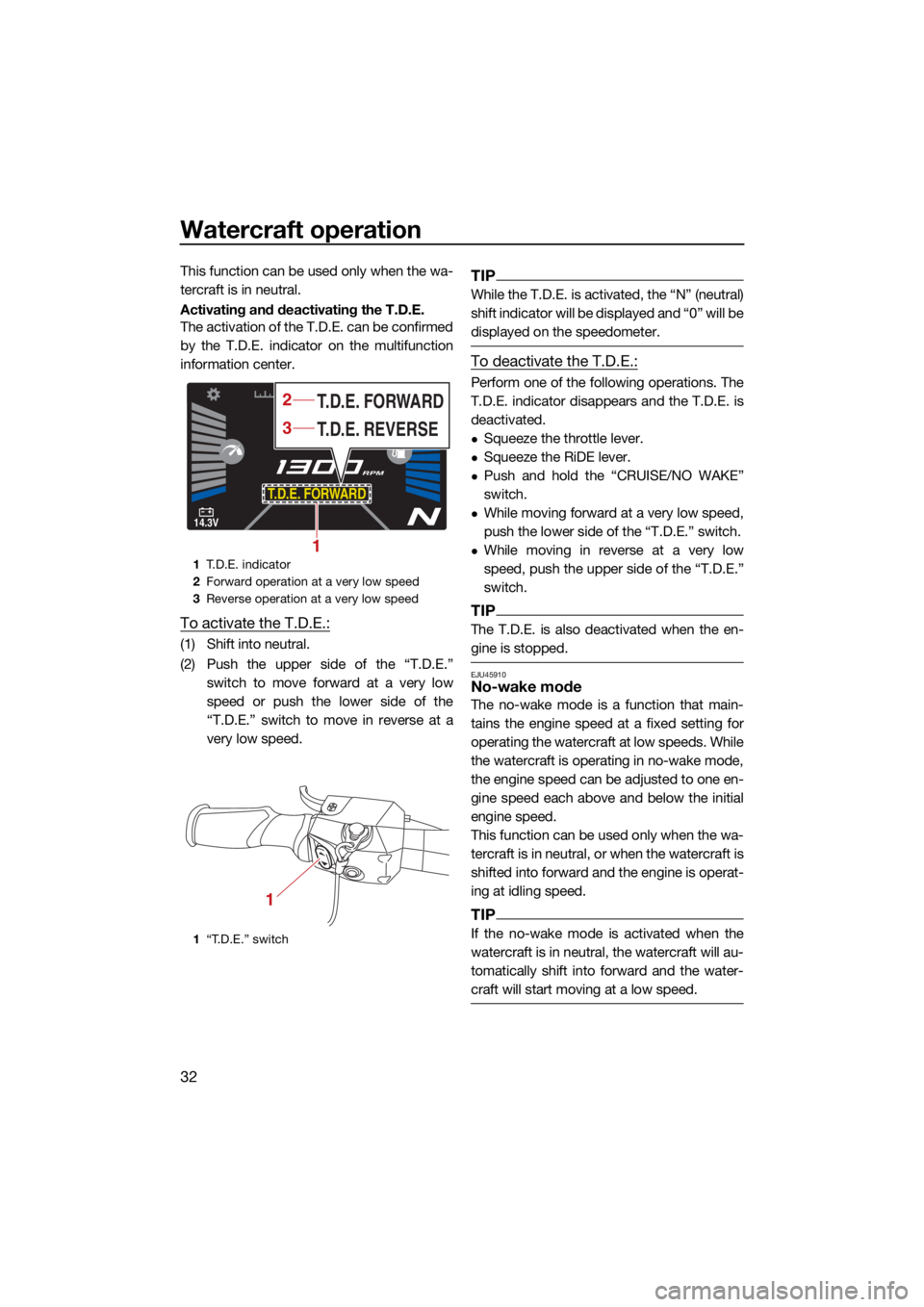
Watercraft operation
32
This function can be used only when the wa-
tercraft is in neutral.
Activating and deactivating the T.D.E.
The activation of the T.D.E. can be confirmed
by the T.D.E. indicator on the multifunction
information center.
To activate the T.D.E.:
(1) Shift into neutral.
(2) Push the upper side of the “T.D.E.”switch to move forward at a very low
speed or push the lower side of the
“T.D.E.” switch to move in reverse at a
very low speed.
TIP
While the T.D.E. is activated, the “N” (neutral)
shift indicator will be displayed and “0” will be
displayed on the speedometer.
To deactivate the T.D.E.:
Perform one of the following operations. The
T.D.E. indicator disappears and the T.D.E. is
deactivated.
Squeeze the throttle lever.
Squeeze the RiDE lever.
Push and hold the “CRUISE/NO WAKE”
switch.
While moving forward at a very low speed,
push the lower side of the “T.D.E.” switch.
While moving in reverse at a very low
speed, push the upper side of the “T.D.E.”
switch.
TIP
The T.D.E. is also deactivated when the en-
gine is stopped.
EJU45910No-wake mode
The no-wake mode is a function that main-
tains the engine speed at a fixed setting for
operating the watercraft at low speeds. While
the watercraft is operating in no-wake mode,
the engine speed can be adjusted to one en-
gine speed each above and below the initial
engine speed.
This function can be used only when the wa-
tercraft is in neutral, or when the watercraft is
shifted into forward and the engine is operat-
ing at idling speed.
TIP
If the no-wake mode is activated when the
watercraft is in neutral, the watercraft will au-
tomatically shift into forward and the water-
craft will start moving at a low speed.
1T.D.E. indicator
2 Forward operation at a very low speed
3 Reverse operation at a very low speed
1 “T.D.E.” switch
14.3V
MPH
RPM
T.D.E. FORWARD
T.D.E. REVERSE T.D.E. FORWARD
1
3
2
1
UF4S71E0.book Page 32 Wednesday, August 4, 2021 5:18 PM
Page 45 of 112
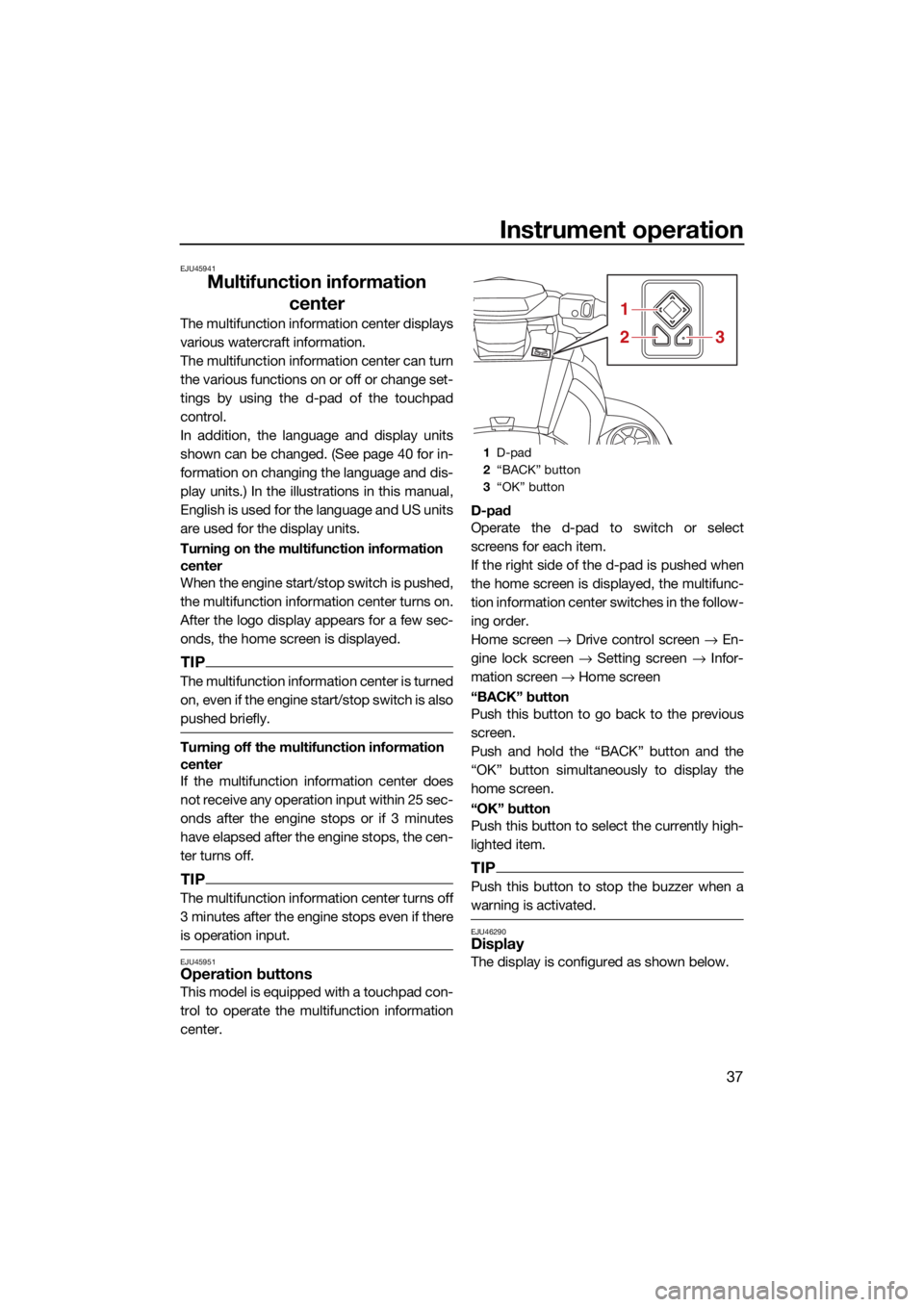
Instrument operation
37
EJU45941
Multifunction information center
The multifunction information center displays
various watercraft information.
The multifunction information center can turn
the various functions on or off or change set-
tings by using the d-pad of the touchpad
control.
In addition, the language and display units
shown can be changed. (See page 40 for in-
formation on changing the language and dis-
play units.) In the illustrations in this manual,
English is used for the language and US units
are used for the display units.
Turning on the multifunction information
center
When the engine start/stop switch is pushed,
the multifunction information center turns on.
After the logo display appears for a few sec-
onds, the home screen is displayed.
TIP
The multifunction information center is turned
on, even if the engine start/stop switch is also
pushed briefly.
Turning off the multifunction information
center
If the multifunction information center does
not receive any operation input within 25 sec-
onds after the engine stops or if 3 minutes
have elapsed after the engine stops, the cen-
ter turns off.
TIP
The multifunction information center turns off
3 minutes after the engine stops even if there
is operation input.
EJU45951Operation buttons
This model is equipped with a touchpad con-
trol to operate the multifunction information
center. D-pad
Operate the d-pad to switch or select
screens for each item.
If the right side of the d-pad is pushed when
the home screen is displayed, the multifunc-
tion information center switches in the follow-
ing order.
Home screen →
Drive control screen → En-
gine lock screen → Setting screen → Infor-
mation screen → Home screen
“BACK” button
Push this button to go back to the previous
screen.
Push and hold the “BACK” button and the
“OK” button simultaneously to display the
home screen.
“OK” button
Push this button to select the currently high-
lighted item.
TIP
Push this button to stop the buzzer when a
warning is activated.
EJU46290Display
The display is configured as shown below.
1 D-pad
2 “BACK” button
3 “OK” button
1
23
UF4S71E0.book Page 37 Wednesday, August 4, 2021 5:18 PM